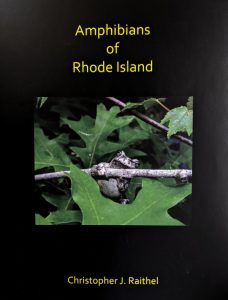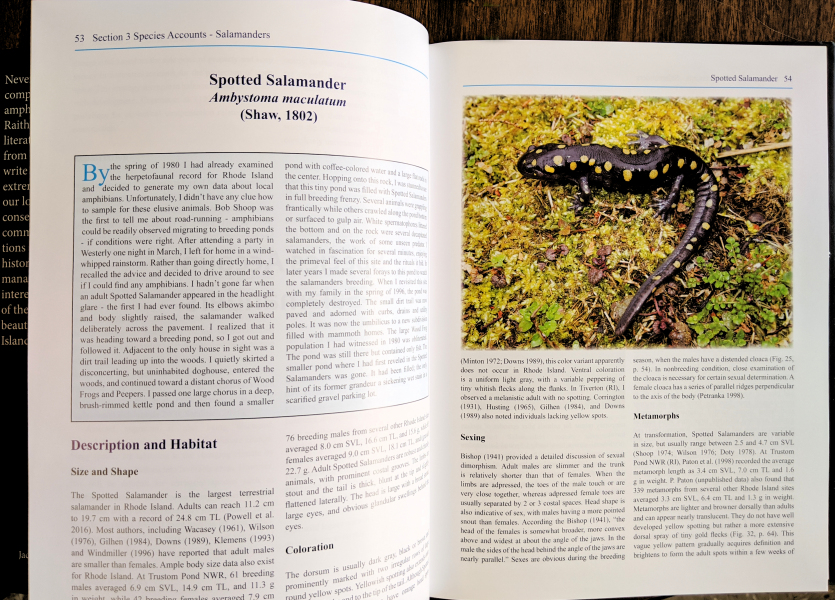By Scott Buchanan, Ph.D., Herpetologist, RIDEM Division of Fish & Wildlife
… As I neared my home about midnight, there was virtually no amphibian activity, and so a stout frog sitting in the road near an area of unpromising oak woodland could not help but draw my attention. Since the only frogs of this size normally found so far from water are the appealing gray treefrog and Fowler’s toad, and because I had barely handled a living thing all night, I stopped for a closer look. ‘Might as well look at something alive,’ I muttered, while focusing the flashlight beam on a frog. My eyes widened considerably as I beheld a large spadefoot.

So begins the anecdote that accompanies the eastern spadefoot toad species account, one of 18 species accounts in the new book Amphibians of Rhode Island written by long-time RIDEM biologist Chris Raithel. Each species account begins with a similar anecdote that brings to life Raithel’s nearly 40 years afield in the state.
The species accounts detail the natural history and ecology of each of Rhode Island’s native frogs, toads, and salamanders. In addition to crisp color photographs of these species (at multiple life-stages) and their habitats, each species account contains meticulously cited information on habitat use, phenology, development, reproduction, movements, conservation status, and more. The book also includes both spatial and temporal data collected throughout Raithel’s career.
Each species account includes a map of Rhode Island with points demonstrating geographic records for that species. The widespread “shotgun blast” of spotted salamander records is in stark contrast to the five or so dots representing northern spring salamander records, mostly limited to the extreme northwest part of the state. For almost all species, easy to interpret bar graphs show seasonal records of occurrence obtained from either road cruising surveys or from call count surveys. Herp enthusiasts seeking to observe these creatures in their natural environment will surely appreciate this information, but nearing 300 pages this hardcover volume is much more than a field guide.
A brief introductory chapter on methodology leads into a much larger chapter devoted entirely to conservation. This section details overarching regional threats as well as the actions we can take if we are to safeguard the amphibian biodiversity found in the Ocean State. With at least two amphibian species, the northern leopard frog and the eastern spadefoot toad, at risk of extirpation in the state, this section reads as a sorely needed how-to guide to prevent their disappearance.

Amphibians of Rhode Island is a book that serves as testament to a long career in which the conservation of our native wildlife was the North Star. Raithel began his career as a zoologist at the outset of the Rhode Island Natural Heritage Program in 1979, later becoming the nongame and endangered species biologist for the Rhode Island Department of Environmental Management Division of Fish and Wildlife until his retirement in 2018. His knowledge of Rhode Island biology and his passion for conservation shine through in his writing. He was awarded the Rhode Island Natural History Survey Distinguished Naturalist Award in 2019 and his legacy as a leading naturalist and conservationist is cemented with this volume.
The book is $20 and purchase options can be found at the RIDEM website HERE.
Amphibians of Rhode Island was published with funding from the U.S. Fish and Wildlife Service State Wildlife Grants Program and all revenue generated by the sale of the book will be returned to wildlife conservation via the Rhode Island Department of Environmental Management, Division of Fish & Wildlife.
Amphibians of Rhode Island, Christopher J. Raithel, West Kingston, RI: RI Division of Fish and Wildlife, Department of Environmental Management, 2019. xiii, 317 p.p., 142 illus.